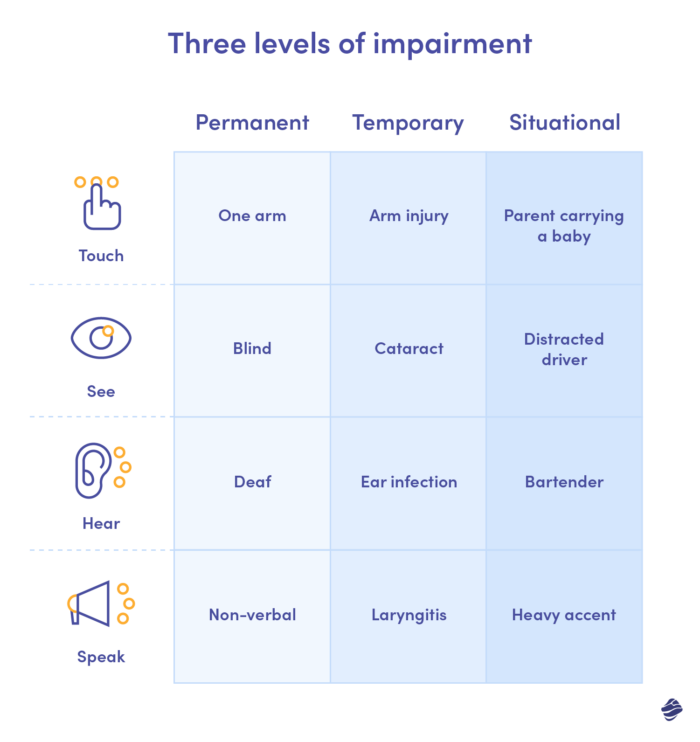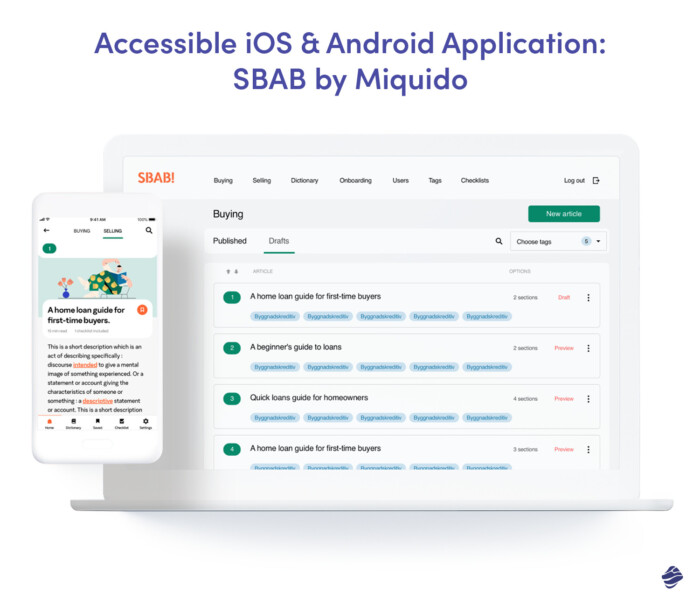Digital accessibility, in general terms, is an inclusive practice, allowing people with various disabilities to benefit from web and mobile products fully. Even though the quest to create digital experiences with no barriers has been steadily gaining momentum, 98% of websites still fail to provide accessibility measures. Consequences can be rather daunting: from excluding large groups of people from being able to use digital products to lawsuits and a troubled brand reputation. Nowadays, accessibility in business is much more than an inclusive gesture: it is a factor that will allow your product to thrive.
So why is accessibility important in business?
Why is accessibility important in business: not exactly an edge case
When it comes to incorporating accessibility into a product design consulting process, many mistakenly assume it is a redundant expense in a seemingly bottomless pit of costs related to running an app. Seeing users with disabilities as “edge cases”, whose unfulfilled needs will have no influence on a product’s success, is an attitude seen much too often in today’s digital landscape.
Instead of relying on assumptions, let’s have a look at facts. According to European Council, almost a quarter of Europeans (translating to 87 million people) have a disability. Statistics in the US look similar – circa 27% of people live with health problems which impact their day-to-day life. And needless to say – the numbers of users translate to profit. Turning our backs to a quarter of potential customers is not exactly a business-savvy decision.
If we dig a little deeper into the concept of disability, it can turn out that our understanding of it is a bit too rigid. The principles of Microsoft’s Inclusive Design help see disability through a less narrow lens. Three different levels of impairment are defined:
- Permanent – a disability as a health condition, e.g. having a hearing impairment;
- Temporary – such as blurry vision as a result of an allergy;
- Situational – a parent holding a fidgeting baby while trying to buy groceries.

Although all three are very different in terms of their impact on life and well-being, there is a conclusion which is definitely worth noting: most of us will, at some point, experience conditions which limit our ability to interact with physical and digital products.
Unlocking business potential of accessibility in business
How do the aforementioned numbers translate to financial figures? According to Forbes, it is estimated that users with disabilities hold about $1.9 trillion in disposable income worldwide. Thus, it won’t come as a surprise that adhering to accessibility principles, e.g. by introducing accessibility in mobile apps, is an excellent way to target and serve a larger customer base, which translates into greater profitability.
Why is accessibility important in business? A good example of how optimising accessibility can help get a competitive edge in business is TESCO. Their focus on creating a frictionless experience for all customers and implementing extensive user testing translated to a 350% increase in sales within a year.
Consequently, treating accessibility with a grain of salt can have a devastating impact on your business. The vast majority (circa 70%) of users with disabilities leave inaccessible websites without attempting to find their way through them – let alone making any kind of purchase. It is no surprise that websites which fail to comply with principles of accessibility in business lose $6.9 billion, as compared to their accessible competitors. No wonder users with disabilities tend to stick to products and brands that cater to their needs.
Accessibility in business: minimising legal risks
Pure financial considerations are not the only factor that we should keep in mind. In some cases, providing an accessible experience to users is a legal requirement. In the US, ADA (The Americans with Disabilities Act) aims to protect people with disabilities against discrimination. Apart from setting accessibility standards for public and commercial facilities, ADA requires public and business entities to offer equal access to their websites and prove compliance with WCAG requirements.
European Commission follows suit – European Accessibility Act will come into effect in 2025. The directive’s goal is to ensure that services which are most vital to navigating in today’s predominantly-digital world are accessible to every user, as well as to unify differing accessibility-related legislation in member states. Some of the affected industries and services will include computers and operating systems, smartphones, digital TV, e-books, e-commerce, banking, passenger transport services, and many more. Very soon, designing products in an accessible way will be a legal requirement rather than a courtesy.
Brand reputation
From Amazon to Domino’s Pizza, the number of companies sued over digital accessibility has been on a constant increase over the last few years. Over 4000 accessibility-related lawsuits have been recently filed in the US.
Reduced screen reader compatibility, keyboard access and navigation issues, lack of alternative text for images and many more breaches are estimated to have cost an average of $25,000 in court settlements. Turning a blind eye to providing equal access to users with disabilities can be an impactful factor in a company’s credibility and reputation.
On the other hand, treating accessibility and diversity seriously can be a great brand asset. Businesses that integrate accessible solutions are not only likely to be considered more innovative but also gain popularity due to being more inclusive. Examples worth bringing up include LEGO, launching a new kind of product – Braille Bricks designed to help children with visual impairments learn Braille; or Microsoft with their Xbox Adaptive Controller, allowing children with physical impairments to enjoy their video games.

In terms of strictly digital accessibility, Barclays leads the way with initiatives such as assistance with sign language for their online banking and ATMs with verbal communication capabilities. Their efforts have certainly been paying off, considering the loyalty rate of users with disabilities.
Accessibility in business: help one, help all
Have you ever heard about the so-called curb-cut effect? This term originally relates to an actual curb-cutting (creating small ramps minimising height difference between pavements and roads) in order to make pavements more wheelchair accessible, which turned out to be advantageous to large numbers of people who did not have a disability. Tourists with suitcases, parents with strollers, children pulling toys and couriers with delivery carts all benefited from this enhancement.

The curb-cut effect, however, does not only relate to the built environment. Investing in digital accessibility can cascade out and up and contribute to a much more frictionless user experience for… pretty much every user. Legible typography, straightforward navigation, accessible UX design services and appropriate text-to-background colour ratios contribute to increased usability for all of your product’s users – apart from being a great help to users with disabilities. Another example is videos with subtitles, which receive as much as 40% more views than those without.
Improved SEO
Although SEO (search engine optimisation) and accessibility are two separate disciplines, they are strongly connected and complement each other. Paying attention to accessibility in business has a positive effect on your website’s SEO, as well as on boosting its organic traffic rankings. There are a number of easy-to-follow, accessible design principles which will both impact user experience and help your website rank higher in search engines. These include:
- Clear header hierarchy (H1 to H6)
It allows users relying on screen readers to navigate content and select specific sections to explore. At the same time, meaningful headings are a good SEO practice and increase your website’s chances of getting featured as an instant answer on Google.
- Alternative text describing images’ content
So-called “alt text” is what screen readers rely on to explain a website’s imagery to their users. From SEO’s point of view, alt text provides search engines with context, in which your images are used and helps them place you higher if they are fit for purpose.
- Video transcriptions
It is estimated that an average internet user spends as much as 17 hours a week on consuming video content. Transcriptions play a vital role in broadening a video’s audience and allowing users with hearing and visual impairments to understand its content. In terms of SEO, video descriptions provide valuable keywords and phrases. Additionally, video captions have proved to increase its viewing time by 12%.
Cost-effective strategy
Accessibility in business is something that is going to catch up with your product sooner or later. Although it is possible to incorporate accessible design at any stage of a product’s lifecycle, creating a digital product with accessibility in mind is a much more cost-effective solution. Addressing arising accessibility issues at later stages will require detailed analyses, fixes and delays in further development. Additionally, it can result in some awkwardly-designed accessibility solutions that are not logically incorporated into the product’s flow and, in turn, bring the users a flawed experience.
At Miquido, we treat accessibility seriously and take it into consideration from day one. SBAB is a fully-accessible native mobile app dedicated to providing mortgage advice. Accessibility is not only a UX design consideration but rather an effort from an entire team engaged in the product’s creation and development. Therefore, we have considered both iOS and Android accessibility features, such as TalkBack, VoiceOver, touch target sizes, appropriate typography and many more. As a result of our team’s effort, a fully-accessible app, which helped all users navigate complex housing market processes, was created.
Accessibility in business equals bullet-proof future
It is hard to ignore demographic trends, which clearly indicate that our population is ageing faster than ever. According to WHO, in just 7 years, 1 in 6 people in the world will be aged 60 years or over, and by 2050 – the population of people of this age will double, constituting as much as 2.1 billion people. Very soon, not including older people in design considerations will albo mean kissing goodbye to a large number of users. Although we might not be able to see it on an everyday basis, our abilities are slowly changing too.
![Elderly people will make up to 22 percent of population by 2050 [source UN via Statista]](https://www.miquido.com/wp-content/uploads/2023/06/Elderly-people-will-make-up-to-22-percent-of-population-by-2050-700x625.png)
Here, once again, the curb-cut effect is worth mentioning. The accessibility in business comes in handy not only because more older users have disabilities but also because accessible design features lower digital products’ threshold in general. Large, legible typography, touch targets with appropriate sizes and easily-resizable content are some of the features that immediately come to mind when thinking about helping your product reach a broader, ageing audience. Therefore, incorporating accessible design in your product is a guarantee of a more bullet-proof future.
Why is accessibility important in business: the summary
Treating accessibility seriously is a strategy that will most definitely pay off. Creating an accessible product will not only allow more people to be able to join in, but it will also bring you very tangible benefits. When you prioritise accessibility, you expand your potential customer base and tap into previously untapped markets, ultimately increasing your revenue and profitability. Additionally, embracing accessibility fosters a positive brand image, demonstrating your commitment to inclusivity and earning the loyalty and trust of diverse customers.In a world that values inclusivity and equal opportunities, investing in accessibility is not just a smart business move or a UX design trend but a moral imperative that will shape a more inclusive future for all.








